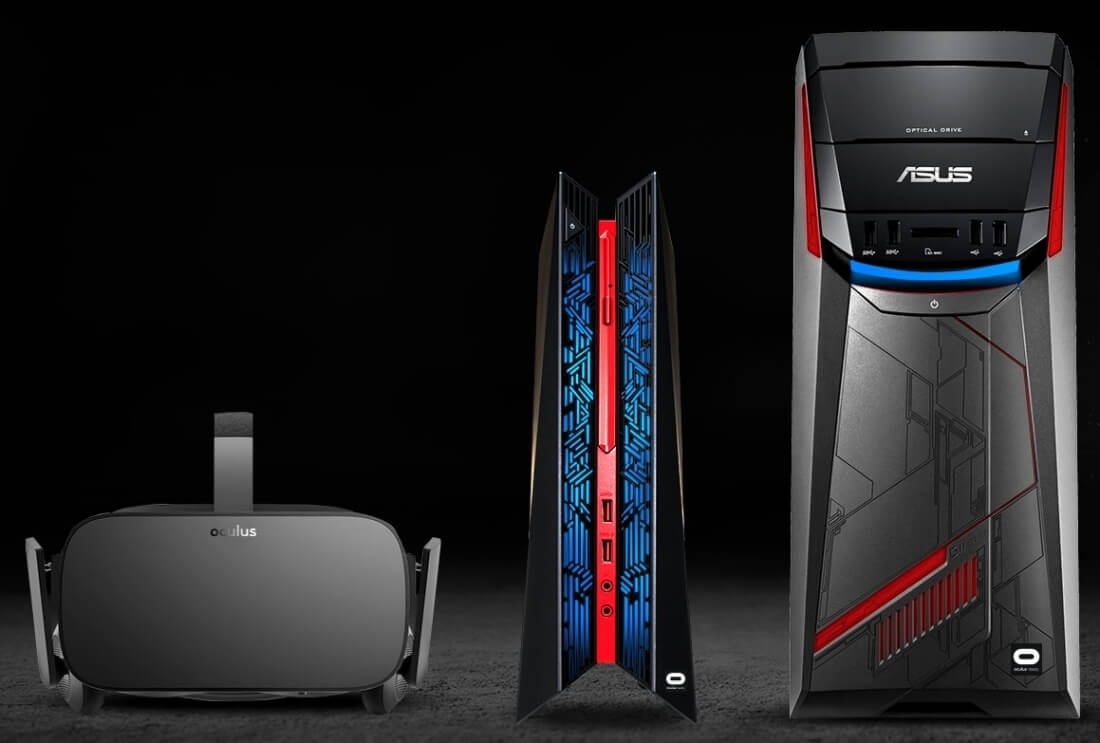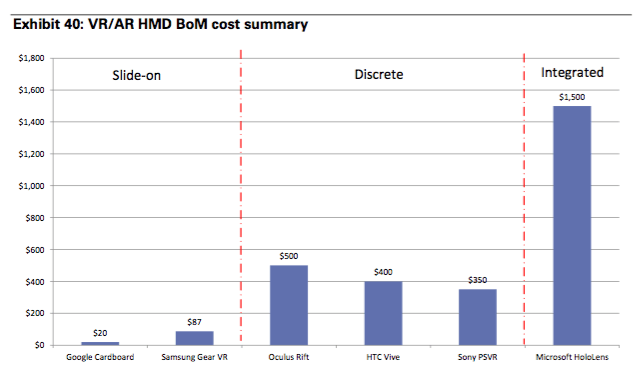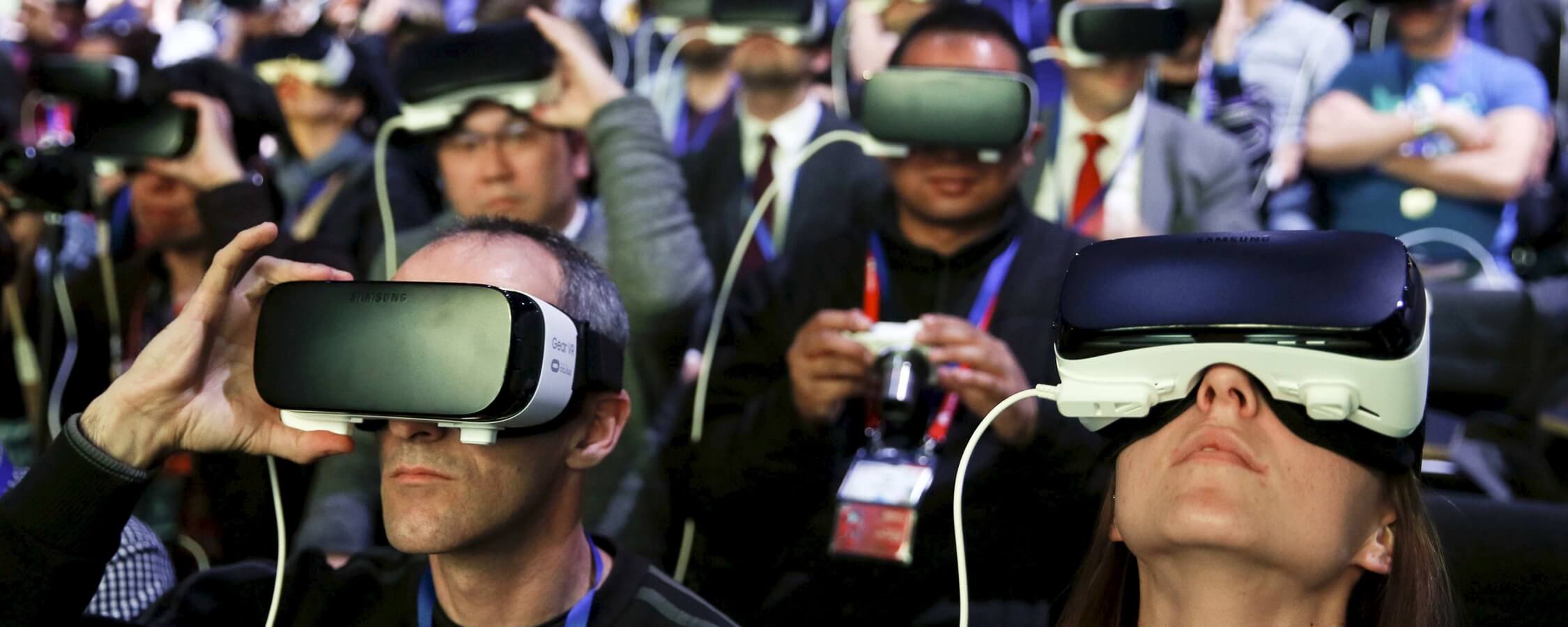Oculus VR, the company that is single-handedly responsible for the modern virtual reality movement, announced in early January that its long awaited Rift headset would retail for a whooping $599. The admission sparked outrage online, leaving many to wonder what drove Oculus to that final asking price and when did the promise of a sub-$400 headset evaporate.
Some went so far as to label the Rift, and VR as a whole, a failure before it even arrives.
A month and a half later, HTC said its Vive VR headset would sell for $799 - a full $200 more than the Rift that had everyone up in arms, though packing motion controllers which Oculus will sell later separately. And just this past week, Sony revealed its virtual reality headset, the aptly-named PlayStation VR, would arrive in October for $399. A few days later, Sony corrected themselves by announcing a PlayStation VR bundle that includes everything needed to get up and running - sans a PlayStation 4 - for an additional hundred bucks.

Samsung, meanwhile, has been selling the Gear VR headset (which requires a Samsung smartphone) since November priced at just $99.
What seems pretty cut-and-dry gets complicated in a hurry when you consider that none of these are standalone platforms; they all rely on additional hardware - be it a computer, a game console or a smartphone - to power the experience.
To help make sense of it all, we've gone through the hassle of analyzing everything to see what the true cost of ownership looks like. Some of the findings may surprise you.
Oculus Rift
The $599 Oculus Rift kit arrives next week and includes the headset itself with built-in headphones and mic, a remote, a sensor, an Xbox One controller, a copy of EVE: Valkyrie, a copy of Lucky's Tale and all of the necessary cables to connect the headset to your computer.
Oculus VR recommends a PC with an Intel Core i5-4590 equivalent or greater CPU, an Nvidia GTX 970 / AMD R9 290 equivalent or better video card, at least 8GB of RAM, a compatible HDMI 1.3 video output, three USB 3.0 ports, a USB 2.0 port and at least Windows 7 SP1 64-bit.
Those in need of a new computer to power the Rift have a few choices. If building or upgrading an existing machine isn't an option, Oculus VR offers a selection of bundles to choose from that include the core Rift kit and a PC that meets its recommended specifications.

Pricing starts at $1,499 for the Asus G11CD-B11 bundle which, when compared with building your own gaming PC, is a surprisingly good deal. Don't believe me? Consider this.
Using Newegg, I put together a system consisting of an Intel Core i5-4590, an Nvidia GTX 970 from Zotac, a Gigabyte GA-B85M-DS3H-A motherboard, 16GB of G.Skill DDR3 memory, a 240GB Kingston SSD, a 700W EVGA PSU, a Samsung DVD drive and a copy of Windows 10 Home 64-bit, all loaded in a Thermaltake V3 Black Edition case for $888.66. Add the cost of the Rift kit and you've got a total of $1,487.66 - just a few bucks cheaper than the entry-level Rift PC bundle.
The Asus G11CD-B11 desktop includes an Intel Core i5-6400, an Nvidia GeForce GTX 970, 8GB of DDR4 RAM and a 1TB 7,200RPM hard drive. I'd personally still lean towards the custom-built configuration as it offers more RAM and a faster - albeit less spacious - storage drive but as you can see, they're matched much more evenly than you might have anticipated.
The other option, of course, is no new PC at all. If you existing gaming PC already meets or exceeds the recommended specifications, you'll need to fork over just $599 to get started with the Rift.
HTC Vive
Developed in collaboration with Valve, the HTC Vive will arrive in early April. In addition to the headset, buyers get two wireless controllers and two base station tracking sensors as well as copies of Tilt Brush, Fantastic Contraption and Job Simulator.
Like the Rift, the Vive requires a respectable computer to drive the visuals. In fact, HTC recommends the exact same CPU and GPU as Oculus VR but with half the RAM at 4GB. A PC also needs at least one USB 2.0 port, HDMI 1.4 or DisplayPort 1.2 or newer and Windows 7 SP1 or later.

HTC has also partnered with several PC makers, offering up "virtual reality certified" machines that are Vive-ready. The cheapest we could find was the HP Envy Desktop 750-220 which retails for $1000. For your money, you get an Intel Core i5-6400, an Nvidia GeForce GTX 970 GPU, 8GB of DDR3 and a 1TB 7,200RPM hard drive.
Alternately, the custom Newegg machine configured for the Rift would work equally as well with the Vive and set you back less than $900.
In summary, you're looking at $1,798.99 for the HP Envy and the HTC Vive or $1,687.66 for the custom-built machine plus the Vive. Or again, if you already have a capable gaming PC that meets the recommended specs, you only need to shell out $799 for HTC's VR platform.
PlayStation VR
Sony's virtual reality platform will arrive later this year (October, to be exact) at a price of $399.99 for the core kit or $499.99 for the PlayStation VR bundle. What's the difference and which should you spring for?
The core PlayStation VR kit includes the headset, all of the necessary cabling, a set of stereo headphones and a PlayStation VR demo disc. Critically, the core kit doesn't include the PlayStation Camera which is a must-have accessory for Sony's VR platform. The $499.00 bundle includes everything listed above as well as the PlayStation Camera, two PlayStation Move motion controllers and one of the platform's launch titles, PlayStation VR Worlds.

If you already happen to have a PlayStation Camera, there's very little reason to go with the more expensive bundle.
Regardless of which kit you choose, you'll also need a PlayStation 4 console to power it. As of writing, the cheapest price on a PlayStation 4 with 500GB of storage is $349 which also includes a copy of Call of Duty: Black Ops III.
To recap, you'll spend at least $399.99 for the PlayStation VR core kit assuming you already have a PlayStation 4 and a PlayStation Camera. If you don't have the camera and also want the Move motion controllers (they aren't required as you can instead use the PS4's DualShock controllers), be prepared to spend $499.99.
If you don't already have a PlayStation 4, you'll be looking at spending a minimum of $798.77 for the PlayStation VR core kit, a PlayStation 4 console and a PlayStation Camera or $848.88 if you buy the PlayStation VR bundle to get the camera and the two Move motion controllers.
Gear VR
Samsung's Gear VR is the only standalone VR device of the bunch and the only one currently on the market. Despite being developed in collaboration with Oculus VR, it offers the least immersive experience.

The good news is that it's also by far the cheapest of the devices discussed here today, assuming of course that you already own the necessary supporting hardware. Here's the breakdown.
The Gear VR headset itself sells for $99.99. Rather than rely on a desktop / laptop computer or game console, the Gear VR requires a newer model Galaxy smartphone which snaps into the front of the device. As of writing, the Gear VR is compatible with the following handsets:
- Galaxy Note 5
- Galaxy S6
- Galaxy S6 Edge
- Galaxy S6 Edge+ (a variant of the Note 5)
- Galaxy S7
- Galaxy S7 Edge
Again, the good news here is that if you own one of the phones listed above, you'll only need to shell out $99.99 to join the VR club.
If not, the cheapest compatible phone - the Galaxy S6 32GB - will add $579.99* to the equation, bringing the total cost of entry to $679.98. On the high end, the brand new Galaxy S7 Edge with 32GB of storage goes for $779.99 which comes out to $879.98 when adding the Gear VR.
Pricing recap
- PlayStation VR Core Kit - $399.99
- PlayStation VR Bundle - $499.99
- PlayStation VR Core Kit + PS4 + PlayStation Camera - $798.77
- PlayStation VR Bundle + PS4 - $848.99
- Oculus Rift Kit - $599
- Oculus Rift PC Bundle - $1,499 (starting price)
- Oculus Rift Kit + DIY PC - $1,487.66 (recommended spec custom built PC)
- HTC Vive - $799
- HTC Vive + HP PC - $1,798.99
- HTC Vive + DIY PC - $1,687.66
- Gear VR - $99.99
- Gear VR + Galaxy S6 32GB - $679.98
- Gear VR + Galaxy S7 Edge 32GB - $879.98
As an Early Adopter, I Am Ready
The cost involved in bringing a new product to market - much less one that's driving an entirely new, cutting-edge market itself - isn't cheap. A recent report from Goldman Sachs (via UploadVR) guestimates the bill of materials for the four virtual reality platforms covered in this article. Unsurprisingly, huge profit margins are nowhere to be found.

Aside from the Gear VR – keep in mind that these are just preliminary estimates – we'll no doubt get more accurate reports once consumer models are on the market and teardowns are performed. What's more, we have to factor in the cost of R&D, marketing and distribution into the overall equation.
Unless HTC, Oculus and Sony want to sell at a huge loss, one could assume that, at least at this early stage of the game, the hardware is reasonably priced.
I've been involved with technology for nearly two decades. During that time, I've witnessed the rise of the Internet, mobile devices and social media, the fall of Nokia, a shift to digital (and later, streaming) music, apps replacing applications, the ongoing movement of television to the Internet and more. Suffice to say, I've seen a lot play out over the years but it's difficult to recall being more excited about an emerging product category than I am about virtual reality.
Perhaps the intrigue correlates to the fact that I haven't yet tried any of the modern virtual reality platforms. In fact, the last time I had a go at virtual reality was in 1995 with the Nintendo Virtual Boy.

We're finally on the cusp of proper virtual reality and unsurprisingly, it isn't cheap. Why that's surprising to some is honestly a bit puzzling. It's called the cost of being an enthusiast, an early adopter. The truth of the matter is, virtual reality isn't yet ready for mainstream consumption as there's not enough content and experiences to keep the attention of the average user.
And really, the current cost of admission isn't all that high when you break it down. An enthusiast or hardcore gamer that's really interested in virtual reality more than likely already has a PC capable of delivering the goods. Even the HTC Vive at $799 isn't unheard of as people - everyday Joes - spend nearly that amount or more on a new smartphone every couple of years without batting an eye. Just because the price of the phone is spread out over the course of two years and you make monthly payments doesn't negate the fact that you're still paying several hundred dollars for it.
If HTC, Oculus VR and Sony offered to let buyers purchase their virtual reality platforms on a payment plan, would we be hearing as much about their "high prices" and how they're already destined for failure? I highly doubt it.
Also read: A List of Oculus Rift & HTC Vive VR Games to Look Out for in 2016
As virtual reality matures, the quality will inevitably improve and more importantly, prices will come down. It's the same formula with virtually (no pun intended) any new product category - HD televisions, 4K televisions, solid state drives, solar power, computers in general, Blu-ray players - the list goes on and on. Assuming that virtual reality is indeed the next big thing (there's little evidence to suggest otherwise), it'll eventually become affordable enough that grandma won't think twice about picking up a headset so she can chat with the grandkids half way across the country.
A few words to the wise. If you're considering a virtual reality platform at this stage of the game, do your homework. Try to demo the model you're interested in as well as the competition so you can make the most informed decision possible. Should you determine you can't live without VR in your life but your PC isn't quite up to snuff, consider overclocking or simply upgrading the components that may be holding you back like the processor, graphics card or RAM. Heck, even buying refurbished or second-hand hardware can save you a few bucks.
Incremental speed bumps every year just don't do much for me anymore. Sure, modern virtual reality is a largely untested technology and I'm a natural skeptic but I'm looking forward to seeing what all the fuss is about.
